Exploring the Meat Market with a Butcher
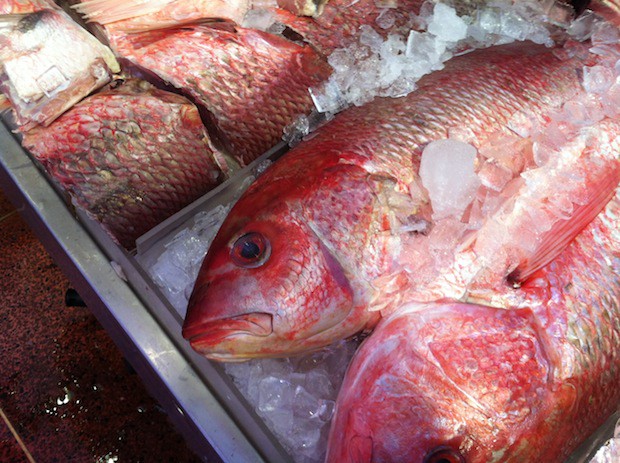
Greg Brockman is a butcher at a fancy grocery store. I’ve been a vegetarian for twelve years and know little to nothing about meat (except that it’s murder, ha). But: People have to eat and no one wants to hear a vegetarian talk about why she’s a vegetarian (really, I’ve checked repeatedly). So: Greg and I visited New York’s Chinatown and Soho’s Dean & Deluca to talk about buying and eating meat in Our Modern World and what the discerning shopper should know about purchasing food that once had a central nervous system.

Logan: Okay, Greg. We’re hanging out in Chinatown, and then we’re going to go to Dean & Deluca. Let’s talk about meat and where you can buy it.
Greg: So the real question here is whether or not the food you eat is worth spending more money than you have to on. Most people in America are getting their food from the suburban supermarket model, which in New York is Key Food, Associated, Shaw’s Supermarket.
Logan: Right. Yes. I agree.
Greg: I don’t work at a place like that. I work at a fancy food store not unlike Dean & Deluca. But most people don’t get their food there, or places like it. And most people also don’t get their food from crazy ass places in Chinatown that have frogs and turtles.
Logan: So where do you think this meat comes from, the meat in Chinatown?
Greg: That is an excellent question, and I don’t know. I don’t know if anyone knows. Most of the meat you get at Key Foods or whatever, is going to be from industrial farming. We all know what that looks like, we’ve all seen Food Inc. or whatever. They’re packed in, they’re all sick, they’re all hopped up on hormones or whatever.
Logan: They have sad lives.
Greg: Yes, they have depressing and sad lives. And that registers. And that is shitty. But they also don’t taste as good! And we’re at this interesting point in food culture where the people whose main concern is ethics are on the same page as the people whose main concern is taste. The beef at my store comes from a farm upstate, which is joke of a fucking postcard of a farm — it’s just beautiful. Rolling hills and clumps of cows just chilling out, not pushed up against each other — these animals have really wonderful lives and eat things that they’re meant to be eating, like grass.
Most of the grain-fed cows that you’ll get in supermarkets, all the flavor comes from the fat. But the cows I sell, they taste better, the texture is better, they cook better, they’re better for you, there are more vitamins and less fat — literally everything is better. And what ends up happening is that you enjoy it so much more. It’s more enjoyable. But the way that happens is way more expensive to the farmer, so you have to pay more. Ground beef at my store is $9.99 a pound, which is three times as much as at a regular supermarket, but it’s also three times better.
I do think that if you’re going to eat meat, particularly land animals, you have a duty to yourself more than the ethics of it, to enjoy it. If you want a steak, you don’t want a grey hunk of sustenance. You want a steak. So you should buy a steak, and that means buying one that tastes good, which means that more than likely it was treated well.
Logan: So we’re the same! Good lives for all animals!
Greg: Well, yes. But I’m still going to buy and eat one of these ducks right now.
DUCKS
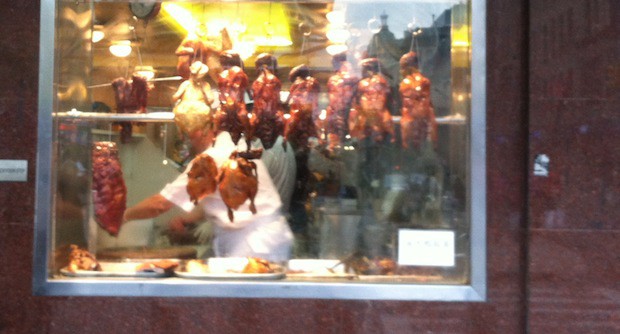
Greg: Look at that.
Logan: Um does that look delicious to you?
Greg: Doesn’t it look delicious to you?
Logan: No.
Greg: There’s not any part of you that doesn’t think it looks unbelievably delicious?
Logan: No.
Greg: That’s crazy. This is a worldwide symbol for food.
Logan: Well, the ones on the bottom look sad. The ones on the top look better.
Greg: Those are the Peking duck.
Logan: Pagan duck?
Greg: Peking duck.
Logan: Oh. They kind of remind me of olden times. I would eat that if it was olden times, and I wasn’t a vegetarian, and I had no choice.
Greg: I think there’s something so primal about a whole roasted animal with the skin and head on and everything. That’s food. That’s straight up food. And it’s $19.50 for the whole duck.
Logan: Can you explain to me why they have their heads on them?
Greg: My guess is that it’s because when you cook a full animal, like if you were to take a whole side of pig and barbecue it, it would taste a million times different and frankly better than if you were to just have ribs or whatever, and it’s because all of the animal’s meat and fat and gristle gets involved. So pork specifically, if you keep the belly and the loin, you get all the fatty goodness from the belly in the mix and all the juices together in this porky magnificence. But I don’t know why they have the heads. It’s probably just how they get them in. Like, there’s less cost. When you get them from the distributor, the more processed it is, the greater the cost.
Logan: Have you ever eaten a duck head?
Greg: No. Never have I ever eaten a Peking duck head.
Logan: I guess I appreciate the ones that have the heads on them.
Greg: Yes. It’s taking ownership. I completely agree with you. You know it’s an animal. It annoys me, people that buy boneless, skinless chicken breasts in a styrofoam package. It’s a little too soylent green. I don’t sell my chickens with the head on them, but I wish I did.
CHICKEN FEET
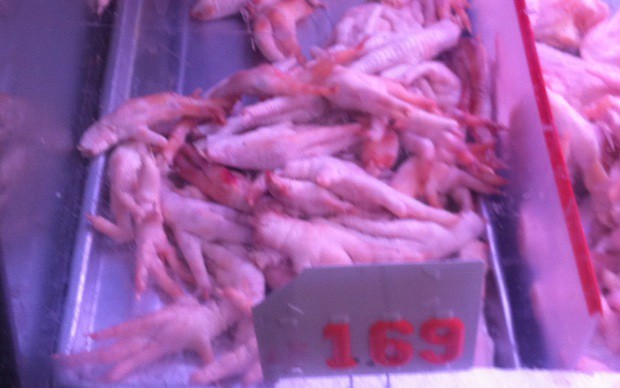
Greg: So these are chicken feet.
Logan: They look like little infant hands.
Greg: I don’t know what kind of infants you know.
Logan: They do! They look like little baby hands. “Hi, helllloooo.”
TROTTERS
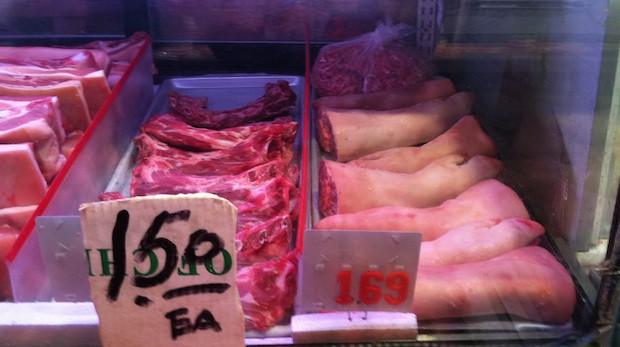
Logan: And those are little piggy hands.
Greg: Pig trotters do look like infant hands. Yes.
Logan: I’m sad.
Greg: Is this making you more of a vegetarian?
COW HOOVES
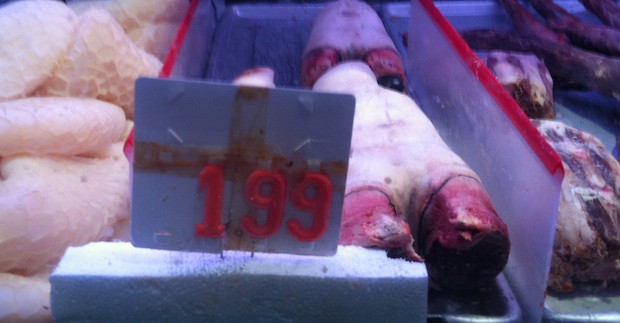
Logan: What would one even do with a cow foot?
Greg: I don’t know. Make glue?
LOBSTERS
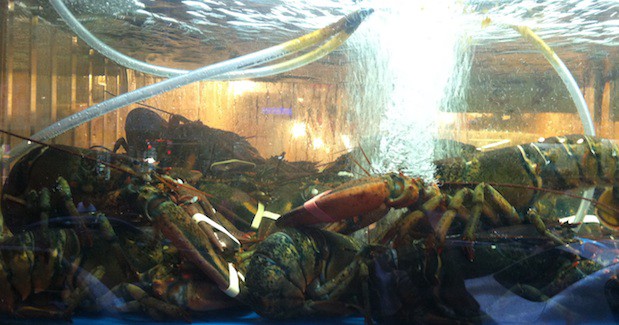
Greg: These things always depress me. This one isn’t that bad. You see a lot of them that are extra depressing, these aren’t too bad.
Logan: Is he missing a hand?
Greg: A claw. Yes. Lost a fight.
Logan: He looks depressed. Or is he dead?
Greg: He’s … pretty dead.
Logan: I know this isn’t what we’re here to talk about, but: Don’t you feel bad about the suffering that is happening right here?
Greg: I don’t know, I have a pretty complicated relationship with that, in that, yeah, kind of? But I’m not going to eat that. And at the same time, I don’t know if I’m comfortable ascribing human emotions to animals. I find it presumptuous.
EELS
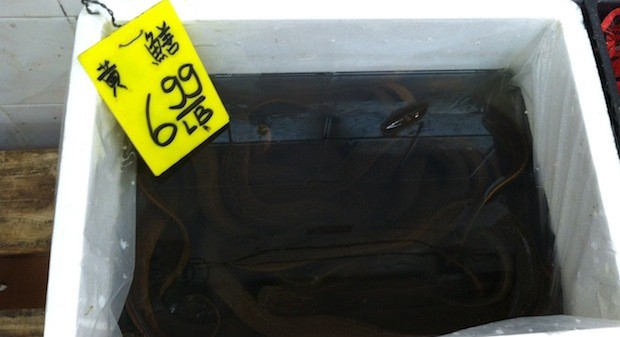
Logan: Does looking at those eels remind you of The Little Mermaid?
Greg: No.
Logan: Not even a little bit?
Greg: No.
Logan: Which one of these is Finding Nemo?
Greg: None of them. You don’t eat clown fish. They’re too little.
Logan: Oh.
[A dude is cutting some stuff up! We look.]
Greg: This is also awesome, watching these guys do their work. Oh look. He’s got a turtle.
Logan: That fucking thing is alive.
Greg: Yeah. It’s alive until it’s dead, dude.
Logan: …
Greg: Okay let’s roll. You’re uncomfortable, I can tell.
Logan: …
Greg: Those turtles are delicious. That’s the thing.
Logan: …
SALMON HEADS
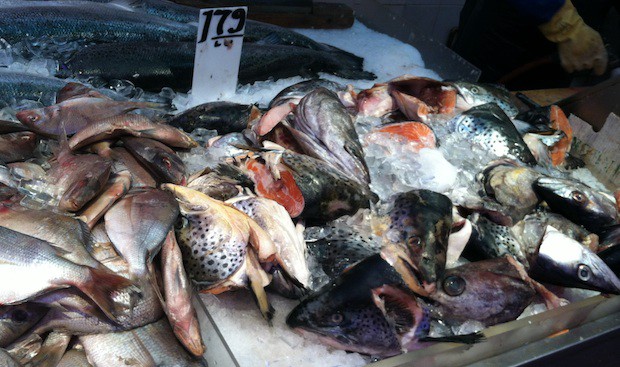
Logan: Okay. Now we are looking at some heads of some fish.
Greg: These are salmon heads, which I haven’t had. But cod heads are one of my favorite things in the world.
Logan: Okay.
Greg: So you’ll notice these don’t have much meat. But if you can get a generous cut with some of the shoulder on it, if you just roast it like a leg of lamb and rub it down with salt and olive oil and put some incisions in it and stuff it with rosemary and garlic, you’d be really surprised how much meat is there. A decent-sized fish head could feed three people easily.
Logan: Hmm. Do you eat the stuff?
Greg: What stuff?
Logan: The gooey stuff?
Greg: Well that’s just blood. But yeah, there are pockets of meat throughout. The cheeks of the fish, the cheeks of any animal basically, particularly fish, are the most flavorful part of pretty much every animal. Maybe not the most, but they’re up there.
FISH PARTS
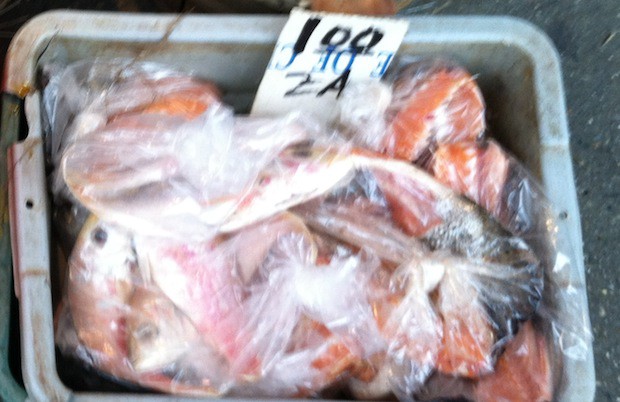
Logan: What’s going on down here?
Greg: Those are trimmings. Mostly bones.
Logan: I’m guessing you’d make soup?
Greg: Yeah, you’d boil it up and make stock.
Logan: And would you do that?
Greg: Make my own fish stock?
Logan: Yes.
Greg: Of course. Always make your own stock. It’s silly not to.
Logan: Right. Of course. Everyone knows that.
FROGS
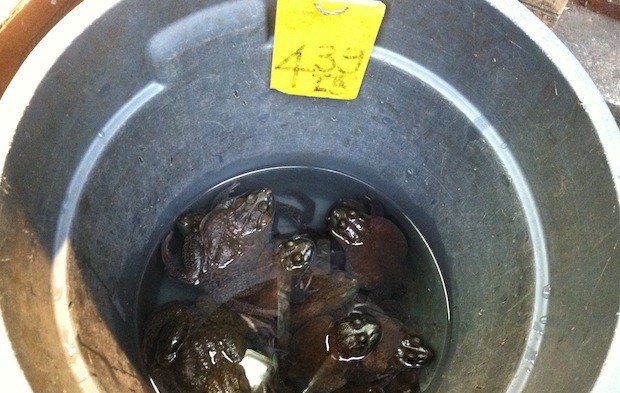
Logan: And now we are looking at a trash can full of very cute frogs. People eat those?
Greg: Yes! They are delicious. But the rule, supposedly, is that you can’t get them during the day, because the health inspectors are still coming around. But after 5 or 6, what is it now, 5:30, they put them out.
Logan: What do you think would happen if I knocked this over and let them all be free?
Greg: I would not help you.
Logan: They’d all get run over by cars.
[And then we journey out of Chinatown into the equally foreign land of Dean & Deluca.]
SUSHI
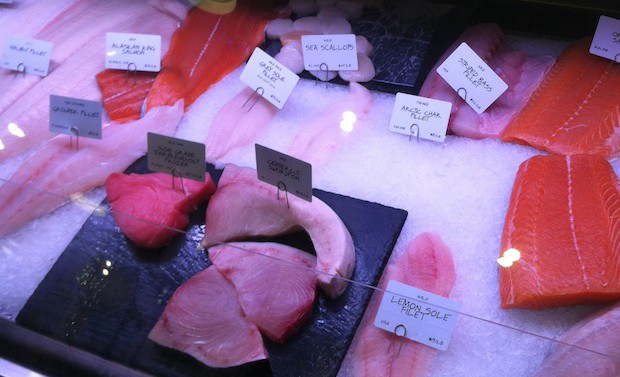
Logan: So: farmed versus wild fish. Go.
Greg: People have a problem with farmed fish and think it’s inherently gross and terrible, which it used to be, and often still is, but it can be really good. Like this farmed Irish salmon is really well done. But people are concerned with it being given dye, which this one isn’t, but some are, and that’s gross and you shouldn’t get it. This tilapia is out of China, which I don’t know about. I know the Honduran farms are good, there’s one in Colorado that’s really good. Basically, find yourself a fishmonger you trust and ask them. Or come see me and ask me.
FANCY CHICKENS
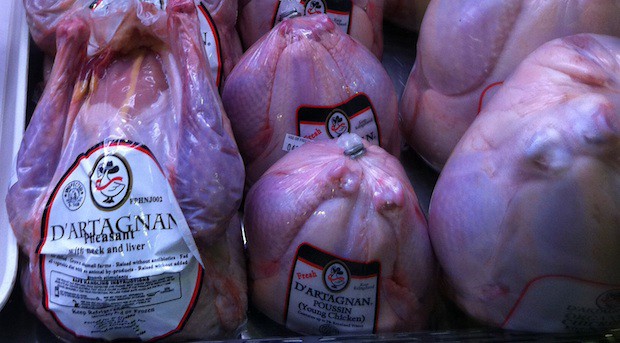
Greg: This is a chicken D’Artagnan distributed. They come from a collection of different farms. Most, if not all, of them are Amish, most are free range, and that’s where they source them. This other farm raises their chickens in such a way that they have generally nice lives, but they don’t get to go outside.
Logan: They have generally nice lives and they can’t go outside?
Greg: Yes.
Logan: No.
Greg: You’re doing your anthropocentric reasoning thing again. You don’t have the capacity to know that. They aren’t physically harmed. Bar the fact that they die.
This other chicken is slightly more industrialized, but it’s more sustainable, in terms of feeding more people. I think we should try to figure out industrial farms so that we don’t have cows with holes in their sides or chicken with their beaks cut off. Because these chickens here, they may not be able to go outside, but they can wander around a huge barn and they don’t have their beaks cut off. They’re not pets, they’re food, but yes they deserve to be respected and not have shitty lives, but it’s not that hard to make a chicken’s life okay. They eat worms! They aren’t particularly discerning animals.
FANCY HAMS
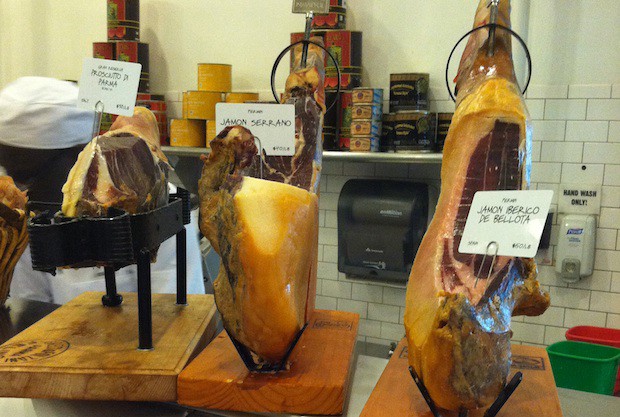
Greg: This is Iberico ham. And it’s $150/pound. The Prosciutto Di Parma is $38/pound. It’s good. It’s made in Parma, but they’re happy to import their pigs from Germany or wherever, and then cure them. But these Spanish hams aren’t like that. If the Spanish don’t have enough of their own pigs, they just won’t make enough, and they’ll be like a dearth, and that’s why it’s a pretty big leap from $40/pound to $150/lb, because they only use a specific kind of pig. With the Iberico breed, they just let them roam around and eat acorns and you can taste it in the flesh and it’s delicious.
Logan: I don’t see how it could possibly be worth it.
Greg: If you can afford it, which, who can, well, except lots of people in this store because it’s Dean & Deluca and we’re in Soho, it’s worth it. It’s worth it to buy the best meats you can buy, or the best anything you can buy, really — produce, dairy, meat, all of it. Opt out of factory farming as much as you can. Seek out the good stuff, the best stuff you can afford. It’s food. You eat it every day. It’s worth a little work.
Greg Brockman is a butcher in NYC.
Support The Billfold
The Billfold continues to exist thanks to support from our readers. Help us continue to do our work by making a monthly pledge on Patreon or a one-time-only contribution through PayPal.
Comments